Help wanted: Labor shortage hits hard in rural West Texas as US slams door on migrants
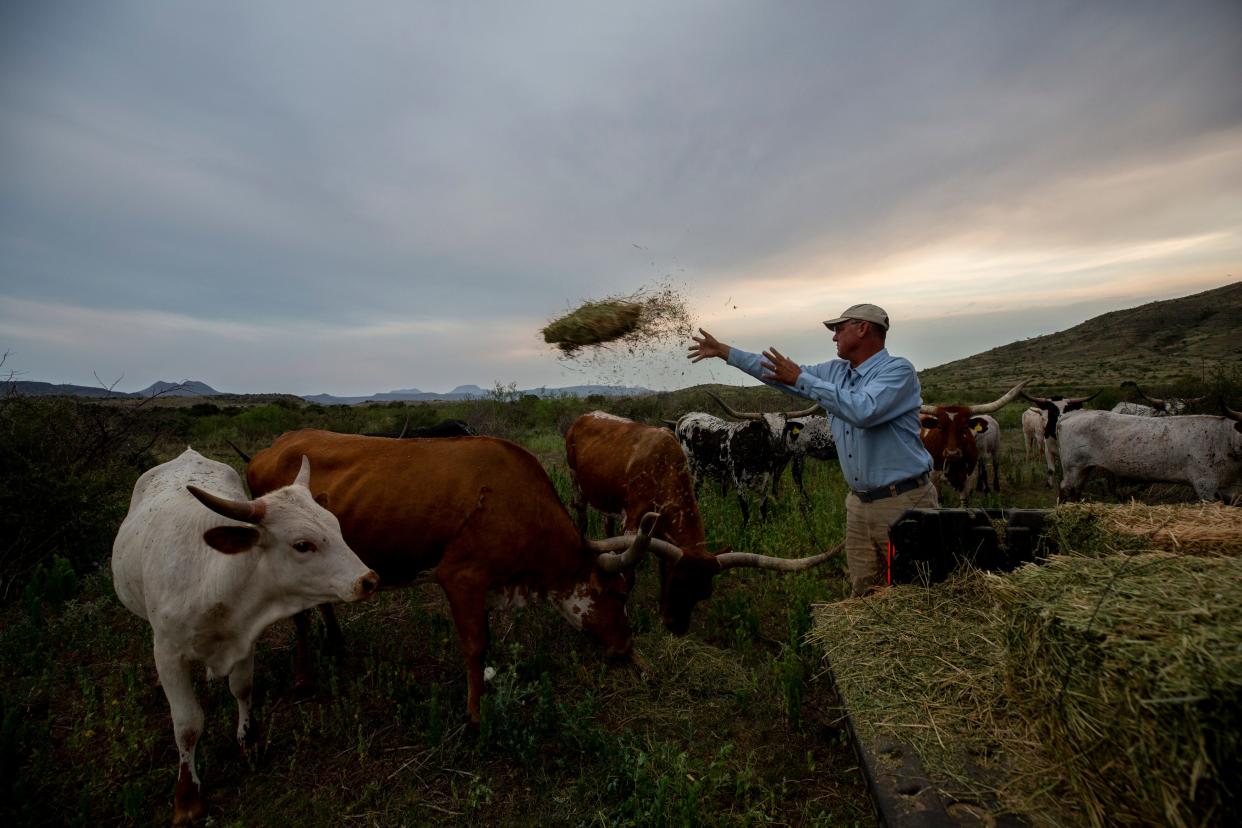
ALPINE, Texas — Katherine Parker rushed around Spicewood Bar and Restaurant, bussing dishes and delivering hot plates of fried catfish and burgers to hungry customers.
She was doing a server's job at the popular eatery with wide-open views of the West Texas foothills and margarita specials on Fridays. But Parker was no ordinary server.
She owns the restaurant. And a hotel. And a cattle ranch.
“I'm always in there working,” she said between the lunch and dinner rushes on a warm weekend in June. “This morning I was in at 6:15 helping with the coffee bar and checking people out (of the hotel). I want to know what's going on in my business. Plus, there’s the labor shortage.”

A nationwide labor deficit has made it near impossible for employers like Parker to hire all the workers they need in industries ranging from agriculture and manufacturing to hospitality and tourism.
The shortage is acute in Far West Texas, where the nearby Permian Basin oilfields siphon workers with above-market wages and stagnant population growth limits the available labor pool.
Yet Parker runs in her businesses in Brewster County at the Texas-Mexico border, where tens of thousands of migrants over the past year have crossed into the U.S., legally and illegally, hoping for a job. She has five openings in her kitchen, where 10 cooks earn between $14 and $20 an hour. She needs 15.
So why is it so hard to find people to do the job?
The United States is facing 3.8 million unfilled job vacancies a month, yet the country has admitted 1.8 million fewer legal immigrants than it would have without the disruption of the COVID-19 pandemic, said Peter Orazem, professor of economics at Iowa State University.
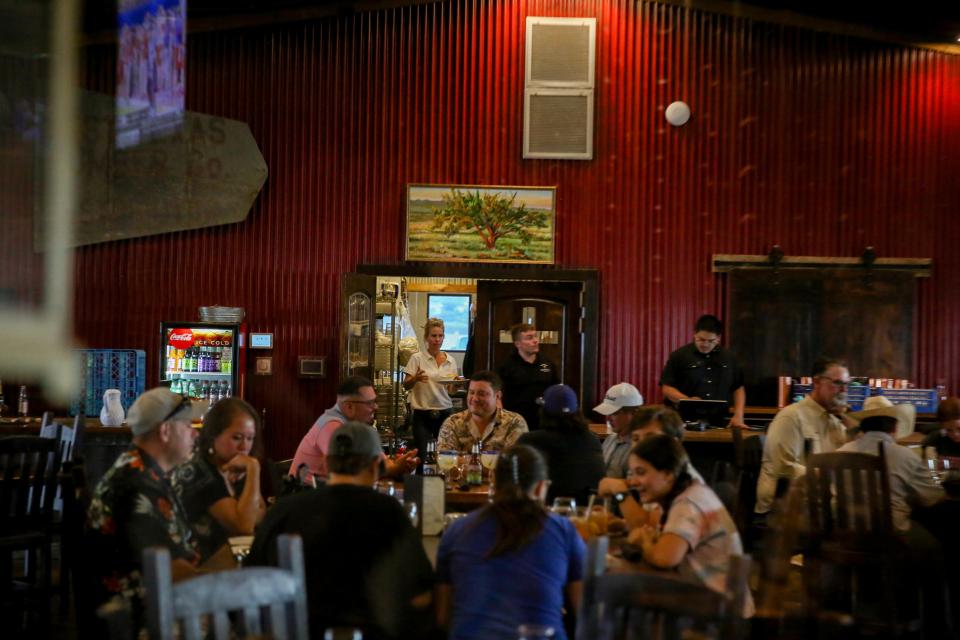
“We used to fill 95% of the vacancies within a month; we now fill 55% of the vacancies,” Orazem said. “We do not have enough workers to meet all the jobs the U.S. would like to fill, and that has been true almost since the beginning of the recovery.”
There are few options to fill the gaping hole in the job market, he said.
"Either older people have to move back into the labor force, or you have to make up for the loss with immigration; we’re not going to change fertility behavior," Orazem said. "The biggest supply chain restriction we have in the United States is labor supply. Immigration is the only way."
The acrimonious national debate on immigration policy happens far from Parker's everyday reality, even as evidence of the need for labor is everywhere she looks.
Parker spent lunchtime expediting orders from the Spicewood kitchen — "expo," she calls it — before heading out back to check on the painfully slow progress being made on the buildout of half a dozen new guesthouses adjacent to her hotel.
The builder is doing his best, she said, but he's also struggling to find help.
'Hiring thin air'
Alpine's population has hovered around 6,000 people for more than a decade, according to the U.S. Census.
Fewer than 15% of residents are listed as foreign-born despite the proximity to the U.S.-Mexico border, and many of the fewer than 200 registered businesses in Alpine are struggling to find workers.
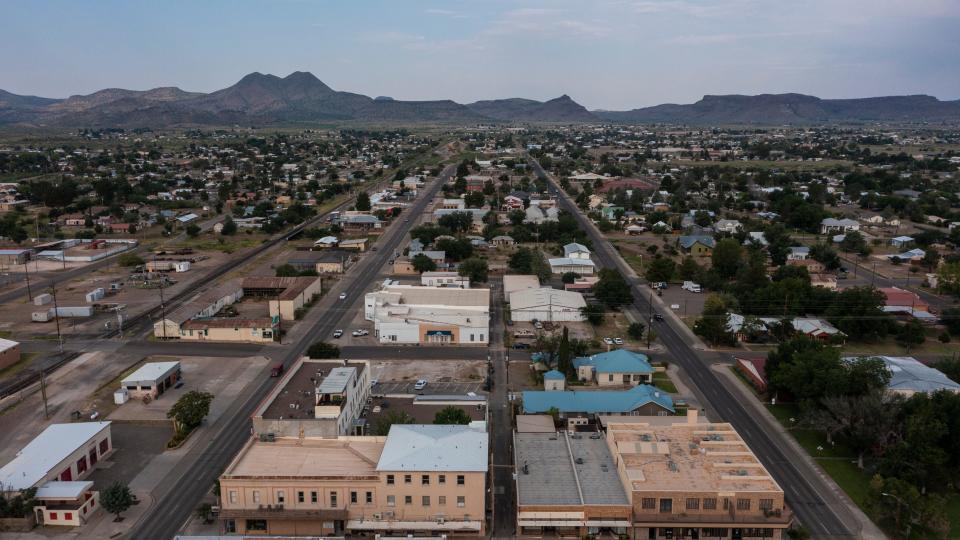
The town is surrounded by sprawling cattle ranches, alfalfa farms and one of the largest tomato-growing greenhouse operations in Texas. It's also a whistle-stop on the West Texas tourism circuit between the hipster gem of Marfa, the dark skies destination in Fort Davis and the pristine spring-fed pool at Balmorhea State Park.
The Holland Hotel and Maverick Inn bookend Alpine's main drag, Holland Avenue. Owned by the same company, the hotels currently share a staff that toggles between the properties checking in guests and changing sheets; wages start at $12 an hour. It's a creative way to maximize staffing, said Michelle Campbell, property manager at the Maverick Inn.
"But you know, on Facebook Marketplace, you'll see such-and-such hotel hiring for $10 an hour for all of these positions and it's like front desk, housekeeping, line cooks, prep cooks if they have kitchens," she said. "It's kind of difficult to watch because I feel for them.
"You're basically hiring thin air," she said. "You're trying to pull people that aren't actually there."
South of town, where Highway 118 ribbons its way to Mexico, Jeff Williams grazes grass-fed cattle for Whole Foods. He runs four ranches near Alpine and two farms, where he grows alfalfa to feed his herd of black Brangus.
On a warm Saturday morning at daybreak, he stacks alfalfa in the back of an all-terrain vehicle and heads out to visit a separate, small herd Texas Longhorns. The cows, tagged on their ears with names like "Penny" and "Ashley," are more family than food supply.
The alfalfa operation is an exact science and very labor-intensive, he said. Much of the work — raking, turning, drying and baling 1,800-pound bales — happens between 11 p.m. and 4 a.m. when conditions are just right.
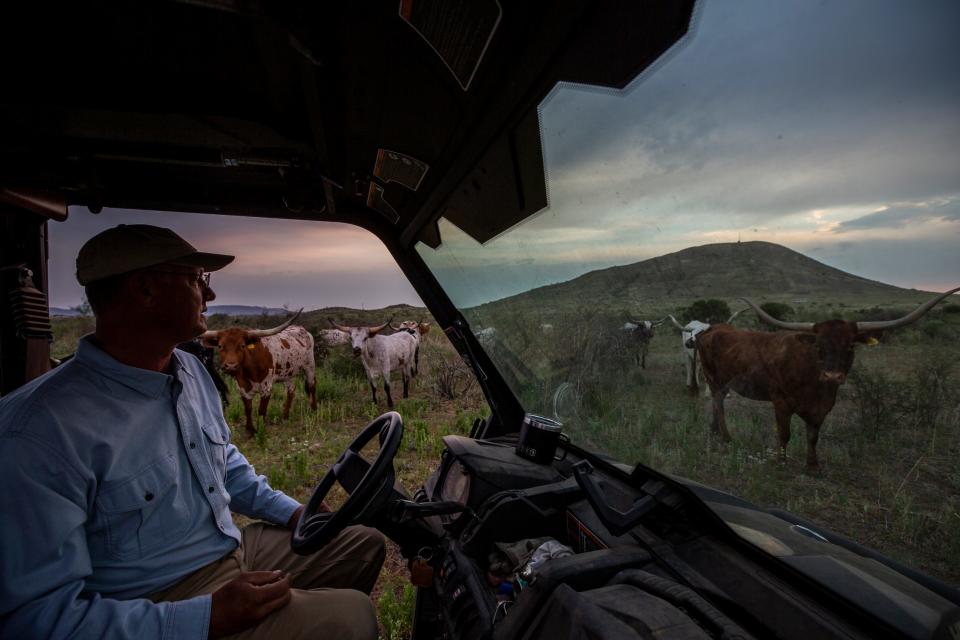
"You have to have the right moisture. You have to have the right temperature, humidity. We have to have winds out of the southeast, off the Gulf, to get the right moisture to be able to bale," he said.
Williams can't find locals willing to do the work.
For the past decade he has relied on the H-2A agricultural work visa program to bring 15 workers from Mexico. But the program is cumbersome, he said, and the paperwork — which has to be refiled every year, even for workers who have already been admitted — doesn't always arrive on time. He lost six weeks of production this spring, when the visas came late.
"I am a month and half, two months behind," he said, "which means I'm not going to get the full utilization out of my investment in the seed and fertilizer and even my guys (miss out). They lost two months of dollars, of salaries, that don't go to feed their family."
An 'opportunity... to fill labor gaps'
While Parker and Williams struggle to find willing workers in Alpine, people from across the Western Hemisphere have been lining up at the Mexican border with dreams of working in the U.S.
Business leaders say the focus on asylum-seekers at the border and immigration court backlogs has clouded the debate around reforms that could meet the current demand for labor and fuel U.S. economic growth.
Southern states like Texas need more workers than any other region in the U.S., according to an analysis of Labor Department data by Moody's Analytics. In March, there were 2 million more jobs in the South than people to fill them.
"There is absolutely a federal equation where we could have more secure borders and immigration laws that better address our very serious labor needs," said Glenn Hamer, president of the Texas Association of Business. "They are not mutually exclusive. If you have a good, workable immigration system with policies for visas, it takes pressure off of migration that tries to circumvent the country’s immigration system."
In Presidio, Texas, a 90-minute drive south of Alpine, Border Patrol's Big Bend Sector reported an average of 1,200 migrant encounters every month from October to May as migrants tried to cross unlawfully, sought political asylum or turned themselves in to agents hoping for an opportunity to work temporarily in the U.S.
Many of the migrants traveled thousands of miles from Central America, South America or the Caribbean, without access to or knowledge of the available visa programs for unskilled workers.
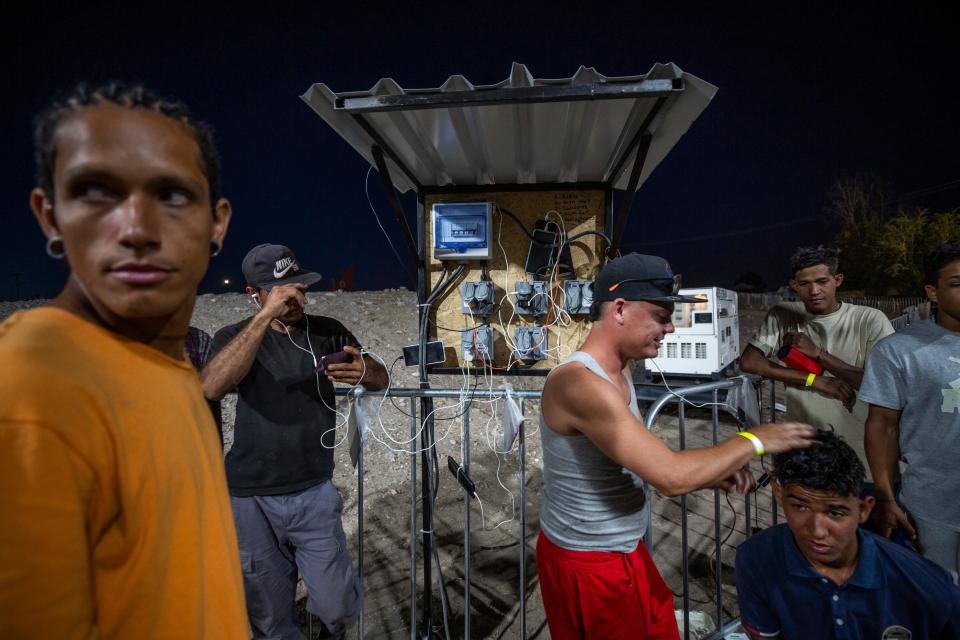
The Biden administration opened a "legal pathway" for some migrants to cross the border lawfully, via appointments made on the CBP One cellphone app. But asylum-seekers and other migrants admitted into the country have often been given "notices to appear" in immigration court months or years down the line — with no permission to work in the U.S. in the meantime.
"There are labor shortages in industries where there haven’t been shortages before," said U.S. Rep. Tony Gonzales, R-San Antonio, whose district includes El Paso and Brewster counties along with more than 800 miles of Texas Borderland.
"It’s not just agriculture or construction; it’s everything," he said. "There is an opportunity to pair up those who are fleeing their countries and fill labor gaps that we have."
Last summer, Michael DeGiglio, the chief executive of Village Farms, wrote a letter to elected leaders in Texas. Faced with a constant struggle to keep his West Texas greenhouses staffed with 600 workers, he urged them to take up reforms that would streamline work visa processes and allow more workers into the country.
A spokesman said copies went to Gov. Greg Abbott; U.S. Sens. Ted Cruz and John Cornyn, both Texas Republicans; and Gonzalez.
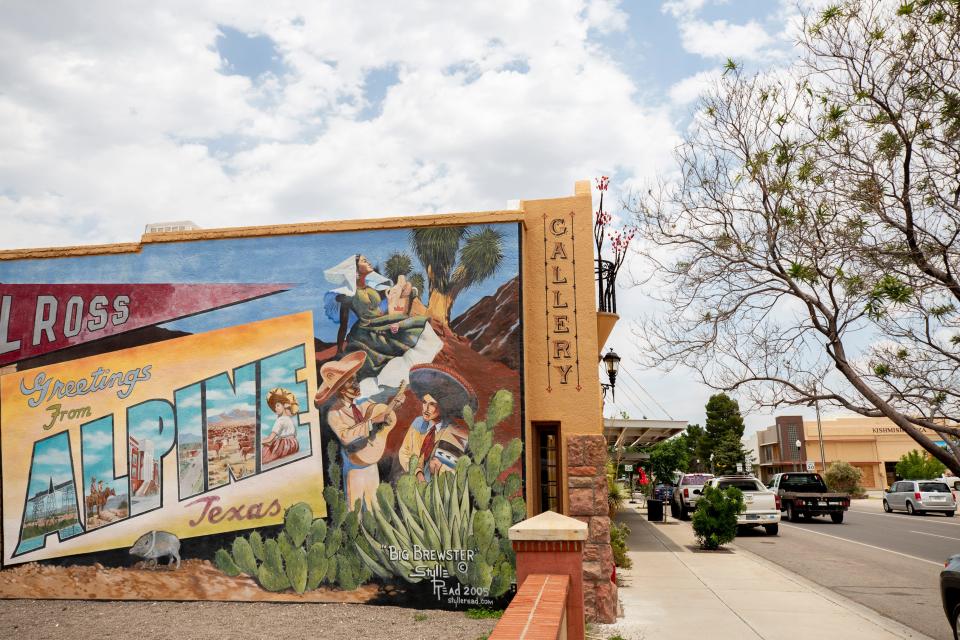
Village Farms isn't the mom-and-pop operation its name evokes. The company, headquartered in Florida, is publicly traded on the Nasdaq and produces tomatoes on 5.5 million square feet of "high-tech controlled agriculture in Texas" near Alpine, Fort Davis and Marfa.
"Thirty years ago, over half our labor force was sourced from local communities," DeGiglio wrote in his letter. "Despite consistent worker recruitment efforts, competitive wages and generous housing benefits, today we are only able to source 5% of our labor from local communities."
DeGiglio got no response from the governor, senators or Gonzales, according to a spokesman.
Village Farms relies on 120 workers with H-2A visas. But its Texas greenhouses are a year-round operation, and the H-2A visas only last 10 months. The rest of the company's workforce is "local" only in the Texas border county sense of the word: Many workers live in Ojinaga just over the border in Mexico, as U.S. citizens or green-card holders.
Gonzales told the El Paso Times, part of the USA TODAY Network, he is working on immigration-related legislation but is still building the bipartisan coalition needed to effect change. There is "a boneyard of politicians" who have tried to tackle immigration reform and failed, he said.
"If you can remove the politics and focus on the need: Start with work visas," he said. "You can solve a lot of problems."
Proposals to modernize the legal immigration system reached Capitol Hill in 2008, 2009, 2013 and 2021, DeGiglio lamented in his letter, but Congress failed to pass legislation.
"We see a serious opportunity with the border crisis," said Derin Gemmel, Village Farms vice president of human resources. "For employers like us to be in the crunch we’re in, and seeing immigrants flooding in, we say, ‘We could use them.’ And we’re told: 'No, they’re not available.'"
'All-hands-on-deck effort'
Aware that the worker shortage is holding back economic growth, the Biden administration is touting its efforts to increase the number of visas available to foreign workers and to accelerate processing. Recovering from a sharp decline in worker visas during the Trump administration, driven by anti-immigration policies and the pandemic, has proved difficult.
U.S. Citizenship and Immigration Services has struggled to keep up with visa demand. In a December "progress report," the agency said it made an "all-hands-on-deck-effort" to process H-2A and H-2B visas, for temporary workers.
"Together, USCIS and the Department of State issued all available employment-based immigrant visas in FY 2022 — double the pre-pandemic number," according to the report. "In the final quarter, USCIS worked cases seven days a week to effectively address pending applications."
The total number of work visas available still falls far below the need.
USCIS issued 298,000 H-2A visas for agricultural work in fiscal 2022, up from roughly 258,000 in fiscal 2021. The administration doubled the number of H-2B visas available to 130,000 this fiscal year.
"The need is tremendous," said David Bier, associate director of immigration studies at the libertarian Cato Institute. "The job opening numbers are still astoundingly high compared to where they were pre-pandemic. That’s just the tip because employers aren’t even advertising the jobs they have."
In Florida: New immigration law sparks fear and worker exodus
In the first half of the year, requests for H-2B visas topped 150,000.
Texas Gov. Greg Abbott has made border security the centerpiece of his political agenda but has rarely mentioned immigration in a labor context. The governor's press office didn't respond to a Times' request for information.
Abbott has famously spent millions of dollars bussing migrants out of Texas border counties to destinations like Washington, D.C., and New York. In July 2022, he authorized the National Guard and state troopers to apprehend migrants who crossed the border unlawfully and return them to ports of entry.
"Of all the states in the union, the governor of Texas is the one who could be playing an outsized role," said Tom Fullerton, economics professor at the University of Texas at El Paso. "The governor of a state like Texas would be able to influence this policy dialogue. It’s something the business sector in Texas needs to convince the governor that this is required."

In Alpine, business owners say they are leaving money on the table.
On a recent warm weekend, one restaurant in town flipped its "open" sign to "closed" at 7 p.m. with tables half full; there weren't enough cooks in the kitchen. The restaurant across the street cut off reservations early, limiting tables to the number their shoestring staff could serve. A fast-food joint prominently displayed a "We're hiring!" sign while one worker ran ragged delivering burgers and fries.
At the Spicewood door, customers waited five or 10 minutes to be seated as a hardworking but strapped staff tried to keep the dining room humming.
For subscribers: I belong here: What it's like to grow up undocumented and without DACA in Arizona
Parker doesn't bother with the government's available visa programs: "It's so many hoops to jump through, it's not really worth it," she said. If she had her druthers, she'd like to see local county judges or sheriffs take a role in recruiting immigrant labor to town, connecting migrants who want to work with jobs in places they've never heard of, like Alpine.
"You've got to bring it down to a smaller level," she said. "How do you eat an elephant? One bite at a time."
A self-described "workaholic," Parker is making up for her labor shortage by doing some of everything in her businesses, every day. She's all but given up on trying to find more workers to do the job.
There's no help wanted sign in the window.
Lauren Villagran can be reached at lvillagran@elpasotimes.com, on Twitter @laurenvillagran and on Instagram @fronteravillagran.
This article originally appeared on USA TODAY NETWORK: Immigration debate: US work visas insufficient to meet labor demand

